As haute couture returns to Milan for the fashion week, we take a look into the symbiosis between cinema and fashion.
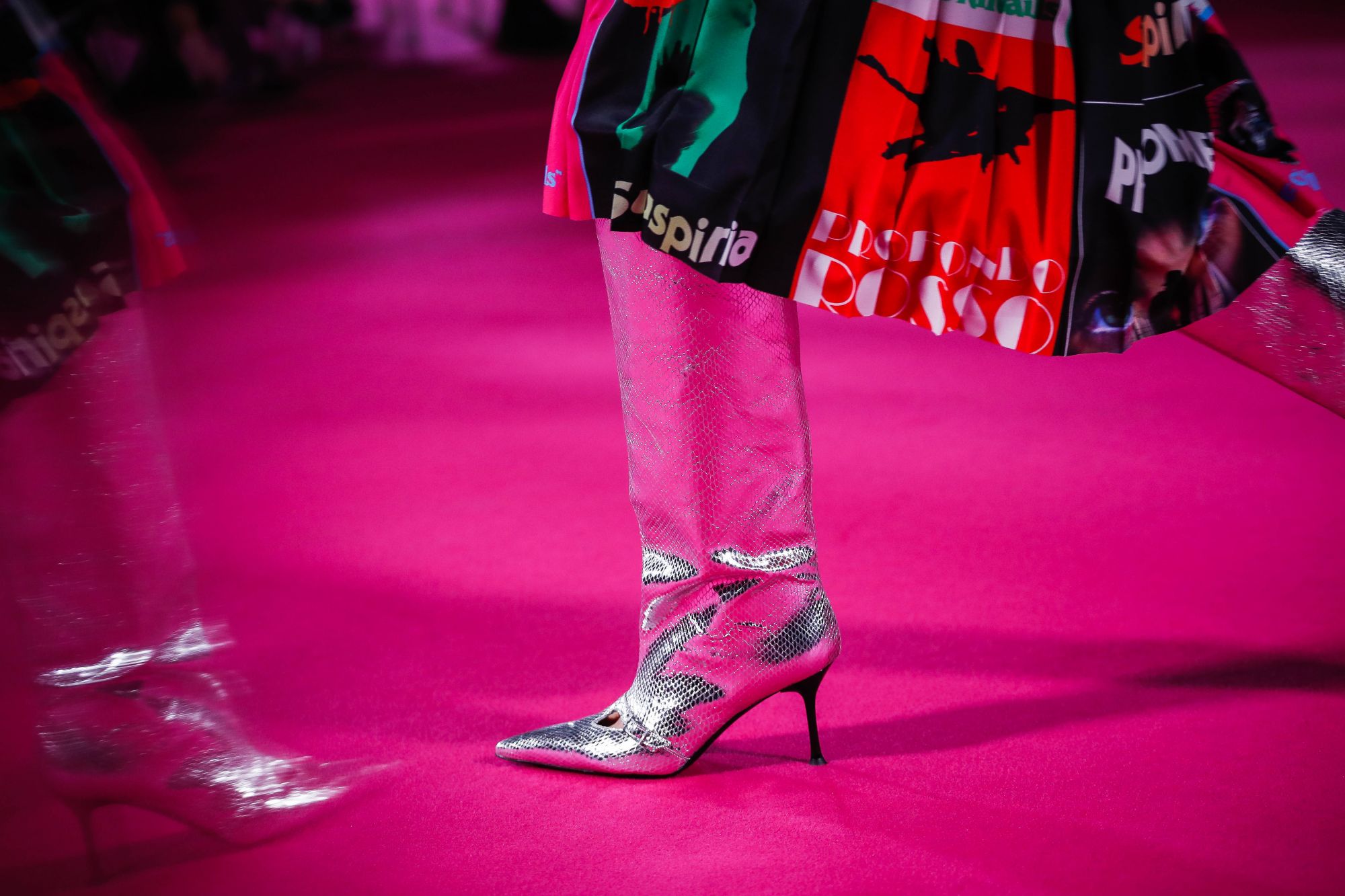
When in 1980 Brian De Palma’s Dressed to Kill hit the screens it came with a pretty self-explanatory title, in which fashion defined the identity of the oeuvre. It stood as a masterful update of the canons of the old thrillers, which auteurs of the likes of Mario Bava and Alfred Hitchcock had helped affirm in the past.
The film, though, also suggested that style and clothing are not to be overlooked when taking into account the power of a cinematic opus. After all, one of the most prized accolades at the Academy Awards is the Oscar for Best Costumes. Italy was a major force at it, especially in the 1960s thanks to the work of Piero Gherardi on many of Fellini’s films, including La Dolce Vita (1960) which in 1962 bagged said award.
Watch Piero Gherardi winning an Oscar for his costumes for La Dolce Vita.
Over the years, the two industries have developed a symbiotic relationship, mutually inspiring each other. On many occasions cinema has commented on the fashion industry and its flamboyance, with films such as David Frankel’s The Devil Wears Prada (2006) and Pret-à-Porter (1994), the Robert Alman’s comedy with a mammoth cast including the likes of Sophia Loren, Marcello Mastroianni, Julia Roberts and Kim Basinger. The latter made indeed cinema history with her timeless look in Basic Instinct (1992), showing how the seventh art, on the other hand, has become a trove of style and creative inspiration for fashion designers.
As a matter of fact, many faces of classic European cinema, like Monica Vitti, have gone through a process of rediscovery that has rightfully elevated them to bona fide icons for fashion moguls, not to mention the never-ending popularity of Spaghetti Western style among creatives – as recently witnessed by Pharrell Williams’ FW24 collection for Louis Vuitton.
It was during the same fashion week that JW Anderson tributed Stanley Kubrick’s Eyes Wide Shut (1999), with a meta-collection conceived as a homage to the art of the film. Rather than focusing on the mood or costumes of the film. Anderson screen-printed on his garments the paintings defining the set of the film and originally made by Christiane and Katharina Kubrick, the director’s wife and daughter, determined to cast a light on their figures as well as to bring to the forefront the background identity of the erotic thriller (and – according to many – Christmas classic).
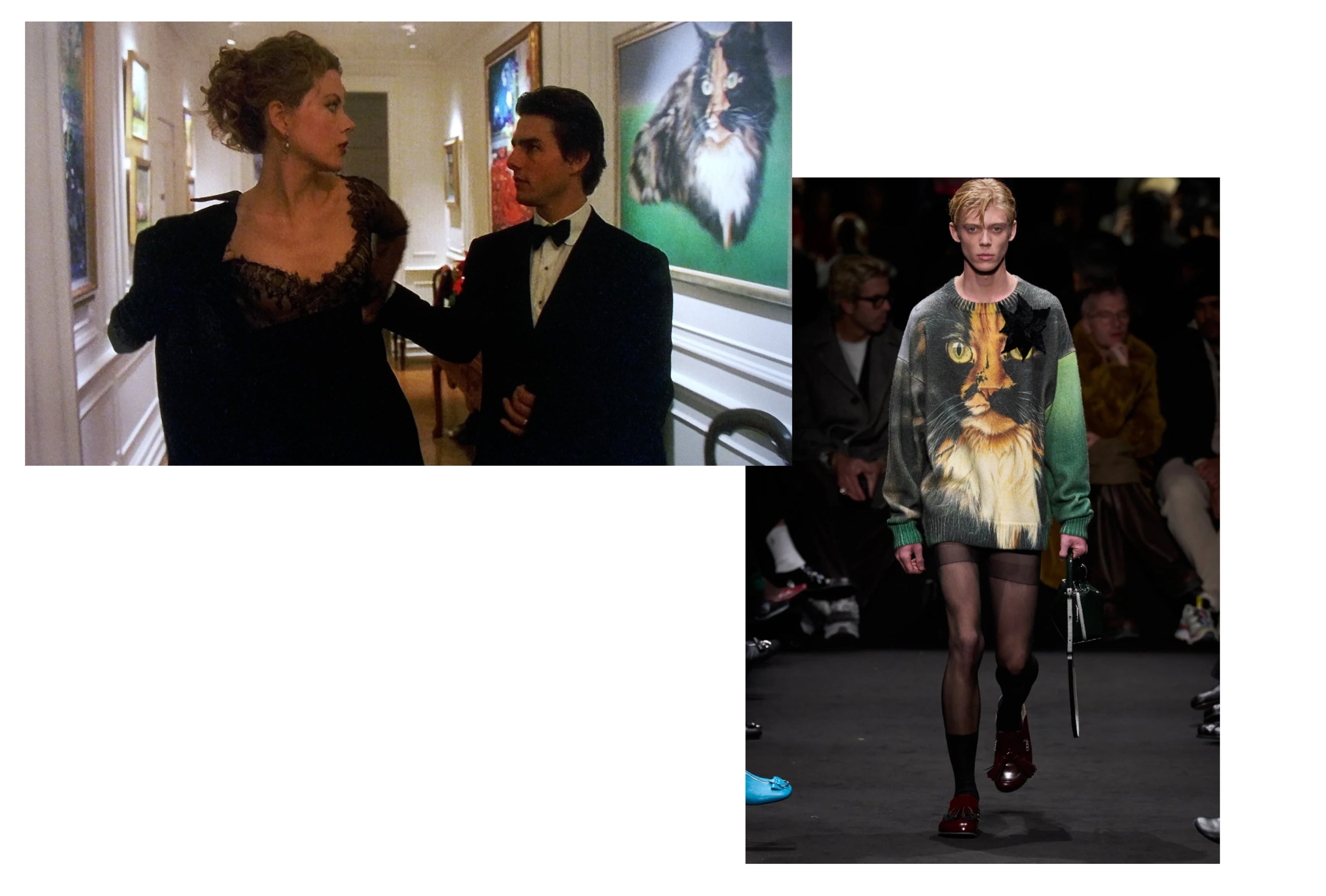
Garments screen printed with enlargements of the Eyes Wide Shut paintings defined JW Anderson FW24 collection.
Just a few months prior to the collection, in the summer of 2023 Johnatan Anderson – who on top of being the mastermind of JW Anderson has also been turning the tide for Loewe as a creative director – had announced his involvement in the designs of the costumes for Luca Guadagnino’s upcoming opus Challengers. Due in theatres only in April, the drama revolving around the world of tennis features in its trailer garments by UNIQLO, the Japanese basics colossus with which Anderson has already collaborated on several capsule collections.
Guadagnino is no new to fostering the bond between cinema and fashion. Not only he worked on fashion films for the likes of Zegna, Fendi, Dior and Jil Sander, but he also had no less than Raf Simons designing the costumes for two of his oeuvres, I Am Love (2009) and A Bigger Splash (2015), a contemporary take on French 1969 classic and fashion bible La Piscine.
Simons loves a good reference, from music and youth culture to, ça va sans dire, cinema. His SS18 collection was, in fact, informed by the gloomy dystopian couture of Ridley Scott’s Blade Runner (1982) and equally nodding to the DIY couture of punks, new wavers and their love affair with PVC and leather. An ode to juxtaposition of references and cultures sliding together bound together by the Ridley Scott masterpiece.
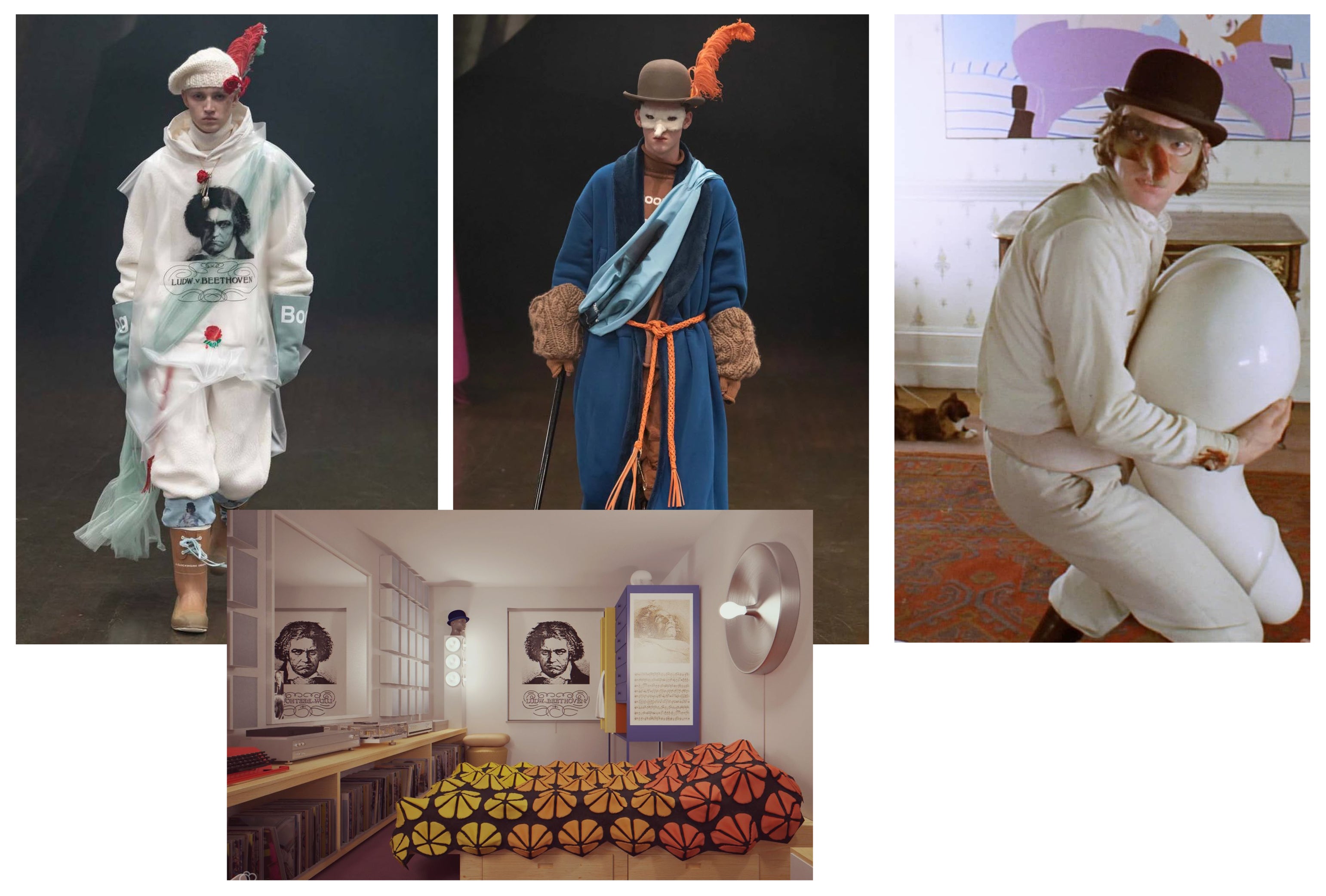
A Clockwork Orange was the inspiration behind Undercover FW19 collection.
Simons’ current co-creative director of Prada, next to Miuccia, serves to further understand the Milanese establishment's love for all things cinematic. From the savvy curatorial project of its cinema within Fondazione Prada to the instant classic FW12 runway show starring some of the most acclaimed names in contemporary cinema, including Willem Dafoe, Adam Brody, Gary Oldman, Jamie Bell and Garret Hedlun.
If the references listed so far may seem like the ABC of film studies, two years later, Miuccia Prada graced fashion devotees with an equally edgier and classier inspiration: The Bitter Tears of Petra Von Kant (1972) by Rainer Werner Fassbinder, allegedly her favourite film.
It was the geometric patterns of the early 1970s knitwear worn in the German film to inspire some designs, but also the subtly luxurious fur detailing of the protagonists coats and nightgowns which resonated with the sombre Milanese bourgeois iconography of Prada.
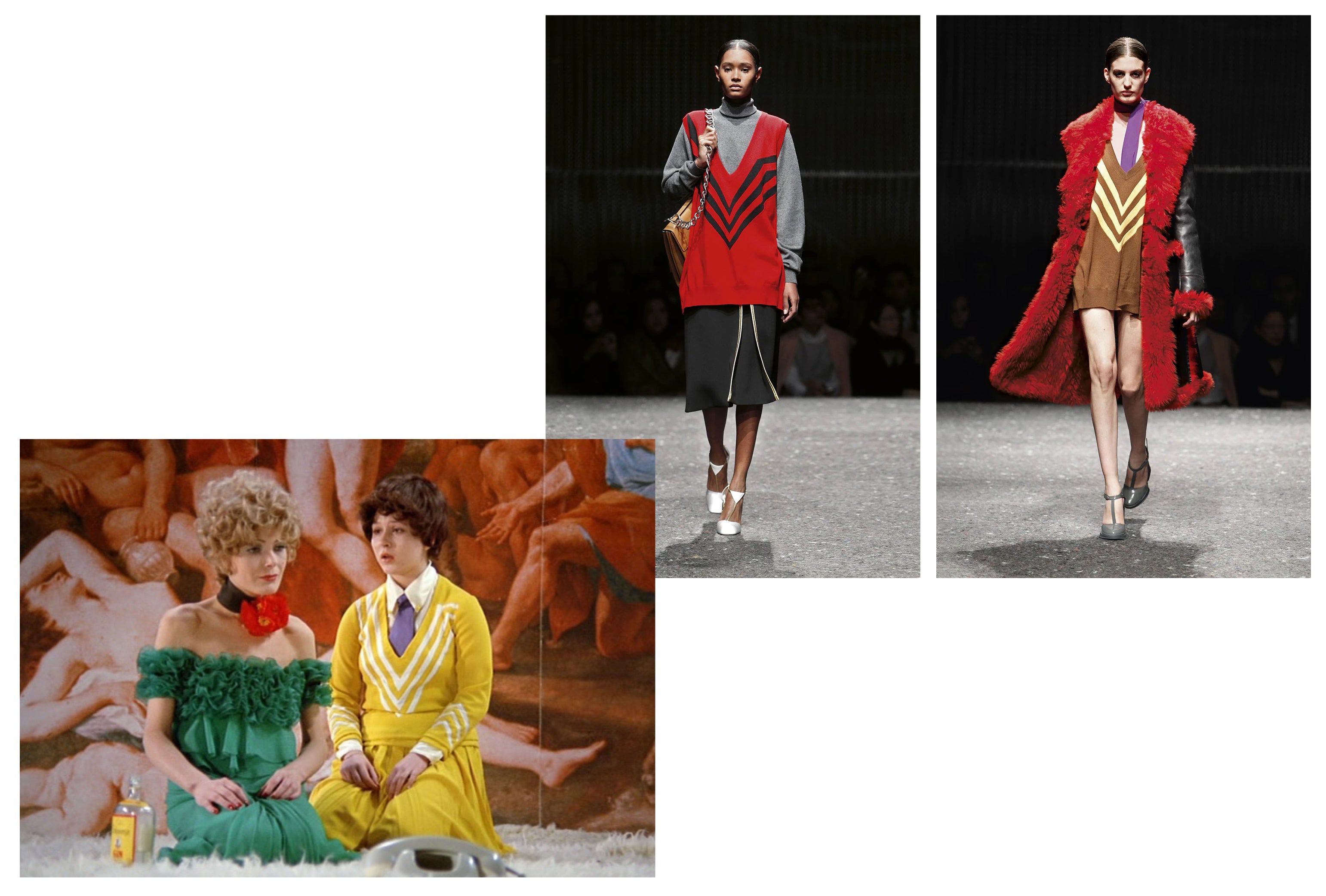
The Tears of Petra Von Kant (1972) is at the core of Prada visual identity.
Horror and thriller cinema seems, however, to be a favourite among fashion designers. Alessandro Michele decided to pay homage to the Coppedè neighbourhood of Rome, the setting of many of Dario Argento’s first Giallo oeuvres, for the Gucci Pre-Fall 18 campaign; while in 2021 MSGM dedicated a whole capsule collection to Argento, with the highlight being a shirt with an enlargement of the theatrical poster of Phenomena, one of the director’s most cherished films.
Undercover, instead, chose another unsettling classic, Kubrick’s A Clockwork Orange (1971) for their FW19 collection, which went as far as designing bowler hats and masks in the shape of those worn by Alex and his fellow Droogs.
Similarly to the brand's touch of screen printing some of the film's most memorable frames on their jackets and tops, French brand Études dotted its FW21 collection with visual references to La Planète Sauvage. The cult 1973 oeuvre by René Laloux made history for being the first animation film to be showcased at Cannes, but also because of its timeless experimental soundtrack by Alain Goraguer, recently reissued by CAM Sugar including 7 previously unreleased tracks.
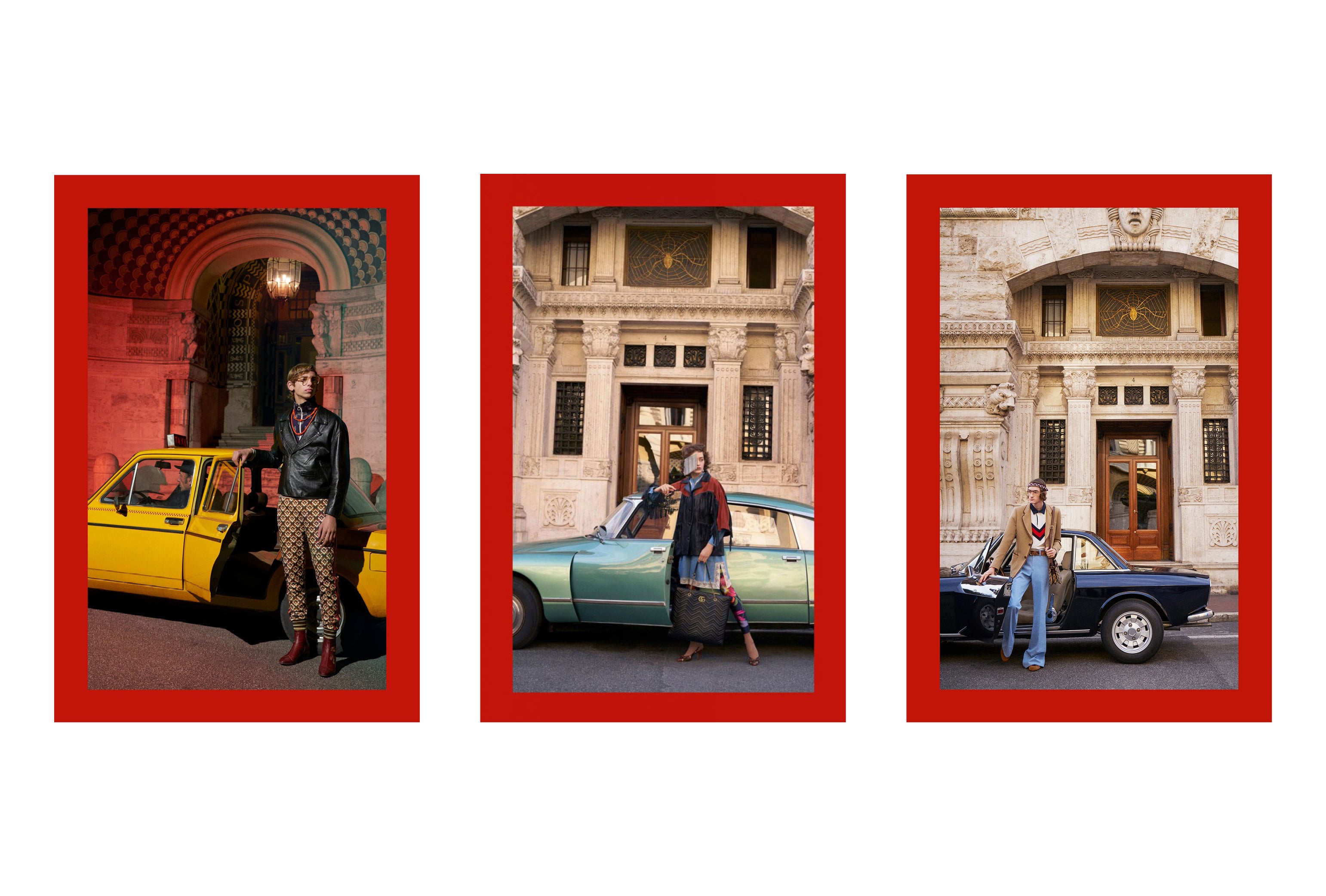
The pre-fall 18 campaign by Gucci was set in the Coppedè neighbourhood of Rome and nodded to the aesthetic of Dario Argento's early films.
Going back in time, Alexander McQueen, was once again visionary in understanding the potential of cinema in haute couture. He did so in his SS95 collection, a tribute to the master of terror Alfred Hitchcok and his The Birds (1962).
Cinema keeps being an inspiration for fashion houses and their communication output also through music. Compositions from the CAM Sugar horror and thriller repertoire provided the soundtrack to the Roberto Cavalli Menswear FW22-23 collection film directed by Tommaso Ottomano.
Watch the Roberto Cavalli Menswear FW22-23 film directed by Tommaso Ottomano and featuring music by CAM Sugar.
Opening image: The Dario Argento-inspired skirt part of the MSGM FW21 collection / Opening icon: A piece from Undercover FW19 collection dedicated to Stanley Kubrick's A Clockwork Orange (1971).